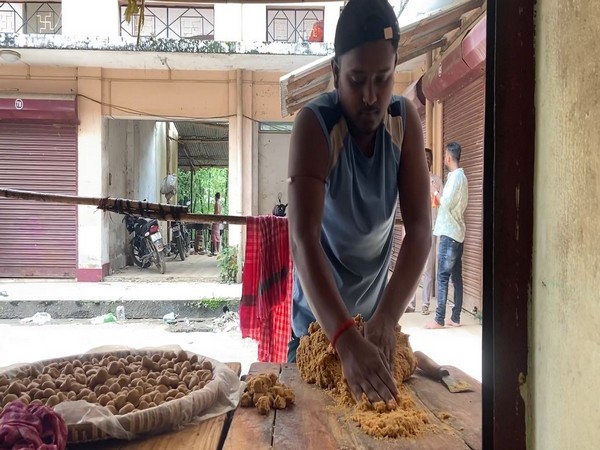The Pera sellers of Tripura Sundari temple are elated as the iconic sweet dish which is a part and parcel of the temple’s identity was accorded the Geographical Indication tag.
There are around 100 privately owned shops in the temple complex that primarily deal in ‘Pera’ which is offered to the deity by almost all the devotees. Even if someone brings other things to offer, “Pera Bhog” has to be there.
Besides, around 50 to 60 people are there who toil hard in the factories to prepare the milk-based sweet dish which was recently accorded the Geographical Indication tag for Tripura.
The Pera sellers of Tripura Sundari Temple are delighted with the development and thanked the Government of India and the Government of Tripura for taking such an initiative to promote the temple at the national as well as the global level.
Speaking with ANI, Tripura Sundari Temple Pera Sellers Association Secretary, Ratan Chandra Paul said, “I want to thank Prime Minister Narendra Modi and Chief Minister Dr Manik Saha for making concerted efforts to make sure Pera gets the GI tag. All the Pera sellers of this temple who have protected the heritage of Pera are very happy. We have almost 100 Pera sellers who have their shops dotted in and around the temple’s sanctum sanctorum.”
On being asked what is the average production of Pera in the temple, Paul added, “We don’t have a rigid volume of production. In holidays, the rush of devotees rises and hence the total production also hikes. On weekdays, the production is on the lower side. The average daily production is around 1,000 Kg.”
Another Pera seller, Jatan Debnath said that after 2018, the footfalls of devotees rose at an unprecedented scale. According to Debnath, who inherited the shop from his father, he had never seen such crowd gathering in the temple in his young days that he experienced nowadays.
“After the 2018 assembly elections, we have witnessed that the number of devotees paying a visit to the temple spiked substantially. Earlier, my father and elder brother used to handle the business. Then, we have never seen such a huge crowd. During the COVID-19 pandemic, the footfalls declined due to the curbs imposed at that point of time. Since then, the number of devotees only increased with every passing day,” Debnath told ANI.
He also thanked the state government for improving the facilities for the devotees in the temple premises. “We the Pera sellers want to thank the BJP-led state government for all the development works that have happened over the years in the temple which is bringing devotees from faraway places,” he added.
Interestingly, the Pera sellers are not the people who prepared the delicate sweet dish. The Pera shop owners buy milk and assign the task to the makers who give the sweet dish its final shape and taste.
One of such Pera makers is Rupan Nama who had taken up this as a full-time profession eight years back. Sharing his experience, Nama said, “Every day 200 to 300 Kg of Pera is easily produced in the whole unit which goes up to 1,000 Kg to 1,200 Kg during the Deepavali festival. It is worth noting here that during Deepavali, the annual festival and fair is organized in the temple.”
“The art of making Pera is very old. Ever since the temple came into existence, Pera-making started here. Every day, 250 to 300 Kgs of Pera is produced on average. Sometimes, we are asked for higher production. When the Deepavali fair is organized, the total production goes beyond 1,000 to 1,2o0 kg per day. In between 100 kg to 200 kg is a regular affair,” he added.
The complete making process of the sweet item is operated manually. No machines are used except woven where the milk is thickened through continuous boiling.
Explaining the process of making Pera, Suman Das, a Pera maker said, “We boil the milk for a certain period so that it turns thick and the Kheer could be derived. That Kheer is mixed with sugar and the hand rolling technique is applied to make Pera.”
On March 31, Matabari Pera was accorded the GI tag along with another indigenous product of Tripura called Rignai.-ANI


